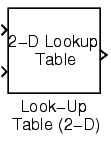

| Simulink Reference |   |
Approximate a two-dimensional function using a selected look-up method
Library
Simulink Look-Up Tables and Fixed-Point Blockset LookUp
Description
The Look-Up Table (2-D) block computes an approximation to some function z=f(x,y) given x, y, z data points.
The Row index input values parameter is a 1-by-m vector of x data points, the Column index input values parameter is a 1-by-n vector of y data points, and the Matrix of output values parameter is an m-by-n matrix of z data points. Both the row and column vectors must be monotonically increasing. These vectors must be strictly monotonically increasing in the following cases:
Interpolation-Extrapolation.
The block generates output based on the input values using one of these methods selected from the Look-up method parameter list:
Interpolation-Extrapolation--This is the default method; it performs linear interpolation and extrapolation of the inputs.
Interpolation-Use End Values--This method performs linear interpolation as described above but does not extrapolate outside the end points of x and y. Instead, the end-point values are used.
Use Input Nearest--This method does not interpolate or extrapolate. Instead, the elements in x and y nearest the current inputs are found. The corresponding element in z is then used as the output.
Use Input Below--This method does not interpolate or extrapolate. Instead, the elements in x and y nearest and below the current inputs are found. The corresponding element in z is then used as the output. If there are no elements in x or y below the current inputs, then the nearest elements are found.
Use Input Above--This method does not interpolate or extrapolate. Instead, the elements in x and y nearest and above the current inputs are found. The corresponding element in z is then used as the output. If there are no elements in x or y above the current inputs, then the nearest elements are found.
To avoid parameter saturation errors, the automatic scaling script autofixexp employs a special rule for the Look-Up Table (2-D) block. autofixexp modifies the scaling by using the output look-up values in addition to the logged minimum and maximum simulation values. The output look-up values are converted to the specified output data type. This prevents the data from being saturated to different values.
When the Show additional parameters check box is selected, some of the parameters that become visible are common to many blocks. For a detailed description of these parameters, refer to Block Parameters in the Fixed-Point Blockset documentation.
Parameters and Dialog Box
Specify via dialog, the Output data type, Output scaling value, and Lock output scaling against changes by the autoscaling tool parameters become visible.Specify via dialog is selected for the Output data type mode parameter.Specify via dialog is selected for the Output data type mode parameter.Specify via dialog is selected for the Output data type mode parameter.Examples
In this example, the block parameters are defined as
The first figure shows the block outputting a value at the intersection of block inputs that match row and column values. The first input is 1 and the second input is 4. These values select the table value at the intersection of the first row (row parameter value 1) and second column (column parameter value 4).
In the second figure, the first input is 1.7 and the second is 3.4. These values cause the block to interpolate between row and column values, as shown in the table at the left. The value at the intersection (28) is the output value.

Characteristics
| Dimensionalized |
Yes |
| Direct Feedthrough |
Yes |
| Sample Time |
Inherited from driving blocks |
| Scalar Expansion |
Of one input if the other is a vector |
| Zero Crossing |
No |
See Also
Look-Up Table, Look-Up Table (n-D)
 | Look-Up Table | Look-Up Table (n-D) |  |